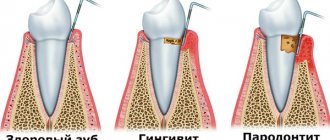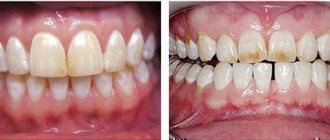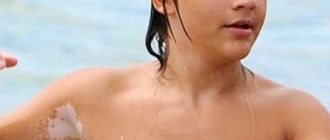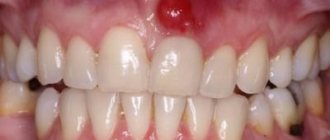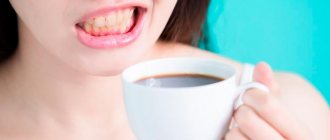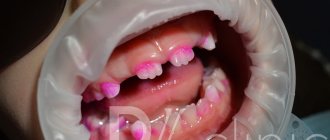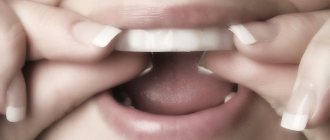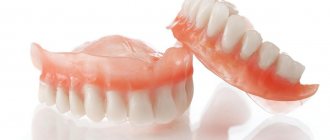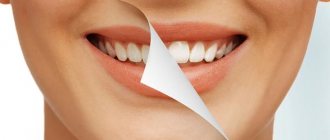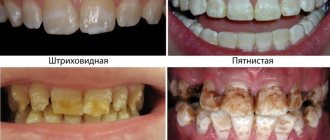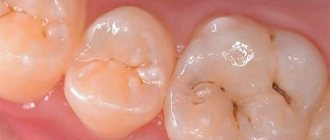Causes
When a person does not move his tongue and jaw for a long time, active proliferation of bacteria occurs, which at this time are not washed off by saliva. For this reason, after waking up, deposits appear on the teeth.
The plaque acquires an unpleasant yellow color if a person ignores the appearance of the film. Over time, the situation worsens, the color of the deposits becomes more and more bright. In this case, it can only be removed in a dental office.
Another factor in the appearance of yellow plaque is genetic predisposition. If the color of the parents’ teeth was repulsive, then with an 80% probability the children will also encounter the same problem.
The appearance of yellow plaque in the socket after tooth extraction is associated with the healing of the wound. This is a sign that the cells are actively working and the process is proceeding normally.
If additional symptoms such as fever, severe pain in the gums, swelling and bad breath are present, we may be talking about the development of a complication - alveolitis.
We are looking for help among improvised means
Home whitening can help get rid of plaque only if there are no associated illnesses. At the same time, it is advisable to reduce your consumption of sweets, switch to quality products and quit smoking.
Folk remedies are not as radical as pharmaceutical ones, but safe when used in moderation. Among the available methods, bleaching with baking soda can be distinguished. It is used as tooth powder, after which it is necessary to carry out the cleaning procedure with regular toothpaste. Some people successfully replace soda with activated or charcoal.
For reference! Baking soda removes plaque as it is an abrasive substance. When using it as an additive to paste, you need to be extremely careful (damage to the enamel is possible).
Main provoking factors
The main reasons for yellow plaque on teeth include:
- abuse of tobacco products (how to clean cigarette residue);
- wearing braces;
- uncontrolled use of tetracycline antibacterial drugs;
- development of gastrointestinal pathologies.
Provocative products
Yellow deposits on teeth in adults appear due to frequent consumption of:
- red wine;
- chocolate;
- carrots;
- blueberries;
- coffee;
- currants;
- black coffee;
- beets.
Causes of different types of plaque
The coating is not always light, ivory-colored. In children it can be yellow, pink, brown, black and even green. Often colored spots are a consequence of the use of dyes of natural and synthetic origin, but it happens that this is a signal of a malfunction in the baby’s body.
The main reasons for the appearance of plaque on teeth include:
- poor-quality oral hygiene (especially hard-to-reach places and tongue) or lack thereof;
- the brush is too soft to remove buildup;
- food particles stuck in and between teeth and not removed after eating;
- excessive consumption of sweets;
- soft food, lack of hard, tough food (apples, carrots, etc.);
- chewing on one side (promotes the accumulation of plaque on the surface of inactive teeth);
- diseases of the child’s internal organs;
- allergy;
- metabolic disease;
- hormonal imbalances.
Dr. Komarovsky believes that dark plaque on teeth occurs for two main reasons: the first is a metabolic disorder in the body, namely calcium, vitamin D and phosphorus, and the second is the drying out of saliva, a natural disinfectant of the oral cavity. If, after eliminating these factors, the darkening remains, you should visit the dentist for an accurate diagnosis.
Plaque that is not removed in time hardens and turns into tartar. It is the culprit of diseases such as periodontitis, gum inflammation, etc. When a stone appears, a visit to the dentist is mandatory.
Raid danger
Yellow plaque on teeth is not harmless. Ignoring this problem can lead to:
- to periodontitis. An inflammatory pathology caused by opportunistic infection of endogenous biofilm plaques. Affects the gums. Often a complication of gingivitis. Without treatment, it contributes to weakening of teeth and their loss;
- overgrowth of tartar. This is a highly hardened plaque that forms on the surface of the enamel. It contains calcium compounds, food debris, epithelial cells, and bacteria. Tartar is not only an aesthetic problem. Usually it provokes the development of carious processes and aggravates the course of gingivitis;
- caries. A pathological process characterized by focal demineralization of the inorganic part of the enamel and the gradual destruction of its organic matrix. Gradually, hard tissues die, and a specific cavity forms in the dentin.
These diseases often recur. In 40% of cases they become chronic.
Plaque on baby and permanent teeth: is there a difference?
Plaque appears on any teeth. There are no particular differences. But dentists note different attitudes of parents towards plaque: if it is noticeable on baby teeth, they may ignore it, especially if the child does not complain. The motivation is as follows: since the teeth are unstable, there is no need to waste time and money on treatment.
But if you treat the problem this way, there is a high risk of:
- gingivitis;
- stomatitis;
- pharyngitis;
- laryngitis;
- laryngotracheitis.
To prevent their occurrence, remove plaque on time. In addition, if the baby teeth were in a neglected state, then the molars could also grow sick.
How to remove yellow plaque?
You can try to remove soft deposits yourself using special pastes. It is impossible to get rid of hardened plaque at home; in this case, professional teeth cleaning will be required.
After diagnosis, the following pathologies can be identified:
Cleaning is carried out only after treatment of these diseases.
Use of pharmaceuticals
You can remove yellow plaque on your teeth with the help of medicated toothpastes, which contain abrasive particles and various active additives. As a result, the plaque softens and is gradually removed.
It is recommended to use pastes containing titanium or silicon dioxide.
These substances are the safest for enamel.
Smokers should additionally use special tooth powders that have a whitening effect.
- Lacalut White. Promotes the destruction of yellow plaque, gentle whitening and restoration of tooth enamel. Reduces the risk of developing carious processes, prevents the development of inflammation and bleeding of the gums;
- Herbal Clove Toothpaste. To eliminate yellow plaque, the use of powder is recommended. It accompanies the destruction of tartar and removes traces of coffee and tea. Eliminates bacteria that cause bad breath. Has an anti-inflammatory effect, strengthens gums and tooth enamel;
- Rembrandt "Antitobacco and coffee." A special paste was developed specifically for smokers, as well as for tea and coffee lovers. Removes yellowness, gently polishes enamel, giving it a mirror shine. The vitamin E contained in the composition helps restore the health of the gums and mucous membranes;
- Lacalut White & Repair. Promotes gentle lightening of enamel. Also intended to restore and maintain the natural whiteness of chewing elements. Keeps breath fresh and prevents the development of pathological processes.
The use of folk remedies
How to get rid of yellow plaque using folk remedies? It is advisable to use them in combination with pastes.
- rinsing with horsetail decoction. To prepare it, pour 30 g of herb into 150 ml of boiling water, leave for 60 minutes, cool and filter. Use for rinsing 2 times/24 hours;
- use of activated carbon. The crushed tablet is carefully rubbed into the enamel. Then you should rinse your mouth and brush your teeth;
- cleansing with lemon zest. It is used to rub teeth. Then you should rinse your mouth with lemon juice diluted in boiled water. The acids it contains help dissolve deposits.
Reasons for appearance
If we could eat with the help of magic pills: swallow one little thing, drink it with clean water, and that’s it, then we wouldn’t suffer from discoloration of our teeth. But until they are invented, we eat foods that sometimes have a coloring effect:
- chocolate;
- coffee;
- beet;
- carrot;
- red wine and much more.
Gradually they eat the white color. In addition, teeth may turn yellow due to:
- smoking;
- treatment with tetracycline antibiotics;
- frequent consumption of strong black tea;
- the presence of diseases of the gastrointestinal tract;
- wearing braces near the place where structures are attached;
- Because the child is too lazy to brush his teeth properly, some of the bacteria settles on them.
We cannot always completely eliminate these factors. But we can remove yellow stains from teeth.
In other cases, we try to clean yellow teeth from teeth at home.
Before you begin whitening, visit your dentist and make sure there are no problems in your mouth:
- carious cavities;
- gum diseases in the acute stage;
- stomatitis and other unpleasant phenomena.
If they are found, treatment will be required first.
Before brown plaque: second stage
When your baby's teeth become yellow, you may need to consult a dentist.
This is not caries yet. However, the formation of yellow deposits indicates that the environment in the mouth has begun to change towards oxidation. The yellow coating is also soft and can sometimes be removed with a brush and floss. If you can’t clean your child’s teeth with these simple home remedies, contact your dentist. He will use a paste to coat the baby's baby teeth. But the effect lasts for about six months. From now on, parents’ task becomes constant monitoring of cleaning.
Yellow plaque appears in children who refuse to use a mug and continue to drink milk and bottled water.
Give your child - if he is old enough - solid foods, they help to cleanse the teeth themselves.
How to remove plaque at home
You can get rid of yellow plaque using traditional methods. Let's list popular techniques that, as practice shows, allow you to forget about yellow teeth and delight others with a movie star smile.
Vodka
An interesting method available at home is getting rid of plaque on teeth using... vodka. This method is contraindicated for children. And if you are over 18, try it.
- Measure out 2 tablespoons of baking soda.
- Add a teaspoon of vodka.
- Pour a teaspoon of lemon juice into the mixture.
- Add half a teaspoon of salt to the mixture.
- Mix the ingredients.
- We brush our teeth once a day for a week.
Thorough cleaning ensures plaque removal in 5–7 days. Store the mixture in a jar in the refrigerator.
Table vinegar
After mixing the ingredients, we brush our teeth with this paste.
- ½ teaspoon of soda.
- ½ teaspoon vinegar.
- ⅓ teaspoon salt.
How to treat plaque
Regardless of the reason for the formation of black plaque in children, rough mechanical cleaning is not recommended. This will not only damage the enamel, but will also bring only a temporary effect - after a while, the black formations will return again. The exception is plaque caused by caries. In this case, you need to contact your dentist and start treating the tooth immediately, removing the formations.
We suggest you read: Swollen gums during wisdom teeth eruption
In most cases, the black spot persists until the baby teeth are replaced with permanent ones, which are less susceptible to plaque.
This does not pose any danger to health, so you just need to brush your teeth properly and take care of your oral cavity.
In other cases, the treatment process depends on the cause of plaque formation:
- If black spots appear due to problems with the intestinal microflora, it is necessary to reconsider the nutritional system. Special medications are also prescribed to establish the balance of microflora.
- If the balance of calcium and iron in the body is incorrect, an appropriate diet is prescribed. If necessary, treatment with medications is prescribed.
- If tooth decay began at an early age, a silver plating or fluoridation procedure can be performed. The process consists of treating tooth enamel with special means that seem to preserve the development of coating pathology. This procedure allows you to wait until your teeth change from baby teeth to permanent ones without serious consequences.
Recommendations from Dr. Zubastik
A snow-white smile is attractive and fashionable. If your teeth have acquired a yellowish tint, try one of the suggested remedies. As a doctor, I still recommend pharmacy methods, not home recipes. And don’t forget about the main condition: before whitening, make sure that the oral cavity is sanitized.
And now, as is tradition, video tips on how to overcome yellow teeth. Let's see?
Typically, a toothache begins to subside on the way to the clinic and finally goes away after 10 minutes of sitting in line to see the dentist.
How to get rid of yellow plaque on teeth
Yellowness of tooth enamel is a cosmetic problem. This especially worries famous people and those who have to communicate a lot by profession. But yellow teeth sometimes indicate certain disorders in the body. To remove plaque, you need to find out the reason for its appearance, and then choose a method to get rid of it. Perhaps, with the elimination of the cause, the plaque will gradually disappear.
Causes of yellow tint on teeth
The tooth enamel of healthy teeth is naturally translucent and has a slightly yellowish tint. This color is given by minerals, the presence of which indicates the strength of the enamel. Under the enamel there is a layer of dentin, which is also rich in minerals. It is this layer that determines the shade of the teeth.
On healthy, even teeth, the yellowish tint of the enamel is not noticeable. An unnaturally snow-white smile can only be achieved through chemical bleaching, which often damages the enamel. All teeth cannot be equally white. The canines are usually yellower than the rest of the teeth in the row because they are stronger.
The naturally yellow tint of teeth is usually inherited. If both parents have yellowish teeth, then the likelihood of passing this feature on to the child is very high. A high level of mineralization guarantees teeth strength and protects them for a long time from caries and other damage.
In addition to genetic characteristics, teeth can also turn yellow due to plaque, which occurs for many reasons:
- Smoking cigarettes or hookahs contributes to the deposition of yellow plaque. Over time, plaque becomes darker, and at the junctions of teeth it turns into stone, destroying the enamel.
- Frequent consumption of coloring drinks can turn your teeth yellow. Such drinks include tea, coffee, pomegranate and grape juices. Raw colored vegetables are also classified as foods with a coloring effect (beets or carrots).
- Insufficiently thorough oral hygiene causes the growth of pathological bacteria that settle on the teeth. In addition, dental diseases occur that contribute to the appearance of plaque.
- Taking certain medications causes yellow teeth. The use of tetracycline and drugs of the tetracycline group affects the color of the enamel. Removing such yellowness on your own is problematic.
- A change in the tone of tooth enamel may indicate any disturbances in the functioning of the body. Strict diets usually lead to such disorders. Mono-diets can be considered especially dangerous. With frequent abuse of dietary restrictions to one product, it inevitably leads to a lack of many vitamins and minerals.
- Oral diseases can also cause yellow plaque to form. Frequent infections (stomatitis, gingivitis) create a favorable environment for the proliferation of microorganisms, which do not always die after the end of treatment. That is why during such illnesses rinsing with decoctions and disinfectants is useful.
Before choosing a teeth whitening method, you need to find out the reason for their yellowness. It is almost impossible to remove natural yellowness and those caused by medications on your own and is dangerous for the condition of the enamel. You can only get rid of such plaque in dental clinics.
Complications of the disease
In addition to the aesthetically unattractive appearance, black formations can lead to other unpleasant complications:
- the appearance of an unpleasant odor from the oral cavity;
- formation of dental plaque;
- decay of tooth enamel due to carious processes;
- the formation of periodontitis due to damage to the gum mucosa due to ongoing inflammatory processes;
- the appearance of a sensitive reaction of teeth to temperature changes and taste sensations;
- bleeding gums;
- development of gingivitis and periodontitis;
- the appearance of inflammatory processes in the gum area.
We invite you to familiarize yourself with Teeth Numbering Schemes in Modern Dentistry
Preventive measures
As you know, preventing a disease is easier than curing it. Therefore, it is necessary to take care of your teeth in advance and follow important prevention recommendations:
- As soon as the first tooth appears, parents should brush it with a special brush. It is put on the finger, after which the teeth are cleaned and the surface of the gums is simultaneously massaged.
- As early as one year, and if necessary, earlier, oral care should begin.
Until the child learns to brush his teeth properly, he should be given assistance. The child must be able to use a brush correctly and know how to brush their teeth. The cleaning procedure should be carried out twice a day - morning and evening. The rest of the time after eating, you should thoroughly rinse your mouth with water or a special product. Paste for adults should not be used when caring for a child’s oral cavity. - After brushing your teeth in the evening, it is not recommended to eat food, especially sweets.
- A one-year-old child should regularly visit the dentist for preventative purposes. This will help identify the problem in time.
- During feeding, adults should not lick the spoon used to feed the baby. Thus, they can transmit bacteria that will cause the baby's enamel to darken.
- It is necessary to monitor the children's diet.
Food should be balanced and contain sufficient amounts of vitamins and minerals. Their intake should not lead to a deficiency or excess of minerals. - You should not allow your child to drink coffee (you can make a weak drink with added milk) or strong tea (it is better to drink green or fruit).
- At the same time, the drinking regime must be correct. Your child should drink enough water, especially in hot weather, to avoid dry mouth.
- Maintain the correct balance of humidity and temperature in the room where the child spends most of his time.
- It is necessary to introduce solid foods into the baby's diet in a timely manner. This leads to proper natural cleaning of the surface of the teeth. You can eat vegetables, fruits, crackers, crackers and hard cookies.
- To avoid drying out of the oral mucosa, it is necessary to ensure that the child breathes through the nose.
- To form a correct bite, you should wean your baby off the bottle and pacifier for up to a year.
Only by caring and attentive attitude of parents to the health of the child’s teeth can one avoid the formation of black plaque and maintain a snow-white smile.
How to remove yellow plaque on teeth at home
When the yellow plaque on your teeth is not yet too thick, you can try to remove it at home. There are several ways to gently whiten teeth at home:
- Baking soda is a good cleaning agent, including for teeth. Baking soda should be used like tooth powder, lightly rubbing it in with a toothbrush or cotton pad. After use, rinse your mouth thoroughly and brush your teeth as usual with toothpaste.
- Crushed activated carbon can also have a whitening effect. Crush one tablet of charcoal and rub it into your teeth with a toothbrush, then rinse your mouth and brush your teeth with regular paste.
- In addition to activated charcoal, you can try whitening your teeth with charcoal or charcoal from fire-roasted eggplants. This type of coal has a more rigid structure, so it is better not to use a toothbrush, but to gently rub the coal with a piece of cotton wool.
- An effective home teeth whitening product is hydrogen peroxide. You can simply rinse your mouth after brushing your teeth with peroxide or rub your teeth with a cotton swab dipped in it. You may experience discomfort in your mouth after using it. The maximum effect is achieved after 0-14 days. It must be remembered that the whitening effect of peroxide is achieved by dissolving plaque on the teeth, along with which the enamel often dissolves.
- Home whitening can be a pleasant experience. Berries such as strawberries and wild strawberries contain whitening components. Rub the cut berry on your teeth and leave it there for a few minutes, then brush your teeth with toothpaste containing fluoride. You can also wipe your teeth with a piece of apple or fresh lemon peel, which will add fresh breath to the whitening effect. Such methods cannot be used more than once every two weeks, since the acid in the listed products can thin the enamel.
- For gentle whitening of teeth with damaged enamel, you can use tea tree oil. After using it, the gums are also strengthened and the oral cavity is cleansed of bacteria. To prepare the mouthwash, add a few drops of oil to a third of a glass of water and rinse your mouth. Can be used a couple of times a week.
- Liquorice has whitening and wound-healing properties. Thanks to its viscous properties, it can be used as chewing gum.
- Sage leaves have antiseptic, soothing and antimicrobial effects. If you have fresh sage, you can wipe your teeth and gums with its leaves after other whitening procedures. An infusion is prepared from dried sage and the mouth is rinsed with it.
Traditional medicine recipes for removing yellow plaque from teeth can lead to damage to the enamel and other unpleasant consequences. Therefore, you need to consult with your dentist to find out how often you can use certain home whitening products.
The following can contribute to early caries of primary teeth:
- Frequent, erratic feedings, especially at night. Caries of baby teeth is also called “bottle caries”, because. Constantly holding a bottle in the mouth, especially with sweet contents, promotes the proliferation of harmful microbes in the oral cavity. At night, the baby produces less saliva and is less active against pathogenic microorganisms, so frequent night feedings are even more harmful for the baby.
- Abuse of sweets. Sweet foods, especially if they remain in the mouth often or for a long time, contribute to the proliferation of harmful microbes and the development of caries.
- Failure of parents to observe the rules of personal hygiene for the child: licking his spoon, pacifier, etc. This is how microbes from the parents’ mouth get to the child and can cause caries in him.
Currently, dentists recommend timely treatment of caries of baby teeth. Therefore, at the first sign of it, you need to consult a dentist. Initial and superficial caries is treated using the silvering method and does not require the use of a drill.
Pharmacy products for teeth whitening
The most common pharmaceutical product for removing yellow plaque is whitening toothpastes. The whitening effect in them is achieved due to a special composition. Many pastes contain microparticles of powder that enhance the whitening effect.
Whitening toothpastes work well with hard brushes. If there is no gum disease, then a toothbrush with stiff bristles will not harm your white teeth. It is also worth considering models of brushes with long bristles, tilting heads and several rows of bristles of different heights and textures. Such brushes provide more complete cleaning even when there is not enough time for lengthy hygiene procedures.
An electric toothbrush is expensive, but provides maximum cleaning of the available tooth surface. The cleaning bristles rotate at high speed, and in a minute such a brush can do more than a regular brush in five minutes. You can remove a small yellow coating even with one thorough cleaning.
Whitening strips
Whitening strips are one of the most popular home whitening methods abroad. They are glued to the teeth and last for about 30 minutes (no more). There are strips with different degrees of whitening and even for sensitive teeth. Even teeth that are naturally yellow can be whitened. The disadvantage of such strips is their rather high price. You can’t buy them in a regular pharmacy or store, only to order.
Teeth whitening gels
Gels are one of the safest pharmaceutical products for teeth whitening. The gel is applied to clean teeth with a special brush and is not washed off. The gel gradually dissolves under the influence of saliva. The method is effective only if used regularly, but it does not work on naturally yellow enamel.
Trays for whitening yellow teeth
A more effective remedy is special mouth guards. They are able to lighten the enamel by several tones. The mouth guard product contains hydrogen peroxide, which dissolves the upper layers of enamel, resulting in increased tooth sensitivity. You must strictly follow the instructions and under no circumstances increase the time you keep the mouthguard on your teeth.
Teeth whitening sticks
Whitening with sticks gives a mild effect of removing yellow plaque. This method is convenient because you can always carry the stick with you. The gel from the stick is applied to the teeth with a special brush for a few minutes, then you can simply wash it off by rinsing your mouth with water. The stick is shaped like a tube of glitter and fits easily even in a small purse. Allows you to immediately remove plaque from coffee and tea, preventing it from sticking to your teeth.
How to remove yellow stains from teeth yourself
A person with an open, snow-white smile quickly wins over his interlocutor, enjoys respect and arouses envy among others. An unpleasant yellow tint or coating can become a serious barrier to communication. How to remove yellowness from enamel? You can whiten your teeth in the dentist's office or using improvised means.
Why does enamel turn yellow?
Before carrying out a course of whitening, it is necessary to find out the reason for the appearance of yellowness in order to select suitable procedures. If the problem has a natural, genetic cause, then folk remedies will not help. In this case, you should only contact a dentist.
A yellow tint on the teeth may appear due to a number of other reasons (acquired). Frequent consumption of “colored” foods has a negative impact on the color of the enamel. Coffee and tea in large quantities also stain teeth. Smoking (cigars, cigarettes or hookah) contributes to the deposition of yellow plaque.
Interesting to know! Tetracycline-based medications and oral diseases (gingivitis or stomatitis) instantly change the color of the enamel.
Fans of mono-diets need to be extremely careful. The consumption of a limited number of minerals, which are necessary for the strength of the enamel, leads to its thinning and the appearance of an unhealthy shade. The same applies to insufficient or incorrect oral hygiene.
We are fighting the problem
The natural color of teeth looks more natural than teeth whitened using aggressive agents. But adding a little whiteness and cleaning the enamel of plaque won’t hurt anyone. Before the procedure, you must visit a doctor and check the condition of your oral cavity. If there are diseases, bleaching begins only after treatment.
You can remove yellowness yourself using pharmaceuticals and folk recipes. The procedures must be carried out in strict accordance with the instructions; after completing the course, do not abuse coloring products, do not smoke. To maintain the effect, you can use whitening pastes.
The benefits of pharmaceutical products
A relatively safe method is special gels that are applied to the enamel and do not require rinsing. They dissolve under the action of saliva and gently cleanse teeth of yellow plaque. The gel can be used with mouth guards, which are alternately placed on the upper and lower rows of teeth, ensuring tight contact of the product with the enamel, preventing it from getting on the mucous membranes. The first results can be observed within a week.
It is important to know! Products containing hydrogen peroxide may cause increased tooth sensitivity. Follow your dentist's recommendations and advice when using them.
Special strips will help lighten the enamel by 2-3 tones (course of use – 30 days). The active composition is already applied to them, and to achieve the effect it is enough to apply the strips for 30 minutes a day. The product has a gradation according to the degree of whitening; you can find options for sensitive teeth. The effect lasts for about two months, then the enamel turns yellow or darkens again.
Disadvantages of this method:
prozuby.com
In what cases is it better to refuse tooth enamel whitening?
It is better not to whiten tooth enamel with home remedies for children, pregnant and nursing mothers. Children's teeth react more sharply to the effects of various agents, which can lead to increased sensitivity and even damage to tooth enamel.
Naturally sensitive teeth are best whitened only in a dental office. The dentist himself will select a gentle remedy that does not destroy the enamel. The same goes for damaged teeth.
You should not get carried away with aggressive whitening if you have fillings in a visible place or a large number of fillings. Whitening agents will not affect the filling material and will stain your white teeth. In addition, the enamel may weaken, and the filling will simply begin to collapse.
Prevention measures
After each meal, you should rinse your mouth to remove any remaining food. The same should be done after tea, coffee and colored juices. Careful oral hygiene prevents not only the appearance of yellow plaque, but also many infectious diseases.
If you cannot get rid of such a bad habit as smoking, then it is necessary to regularly clean your tooth enamel. It is better to discuss the whitening method with your dentist. Home whitening can affect the condition of your teeth, so any methods should be used with great caution.
Causes of dental plaque
Plaque is a disease that does not depend on age. Plaque appears in infants at a very early age and accompanies a person throughout his life.
Plaque on teeth is an accumulation of residues of substances: food, saliva and other sticky substances that enter the oral cavity.
Children's dental plaque
There are three types of children's dental plaque:
- white
- yellow
- dark (black or brown)
The reasons for the appearance of plaque vary depending on the color of the child’s plaque. At first, the plaque may not be noticeable at all and not cause any inconvenience. However, over time it grows, darkens, becomes larger and more noticeable. This is an environment for the development of bacteria and harmful microorganisms. Soft for years, over time it can turn into real tartar.
What contributes to the appearance of plaque? The factors and causes of stone formation primarily depend on proper oral hygiene . If it is insufficient, teeth cannot avoid plaque. Ideally, of course, brush your teeth after every meal, but it is unlikely that children are able to follow this rule. A good habit is to regularly brush your teeth twice a day: in the morning and before bed.
Instilling in your child the habit of brushing their teeth twice a day is the easiest way to avoid plaque
Important: Try to choose a medium-hard brush and the right toothpaste for your child.
The appearance of plaque can be influenced by the food the child eats. So, if he mainly eats soft food, he is more likely to get plaque.
Important: Hard foods (raw carrots or apples, for example) can clean plaque from tooth enamel. Give your child food that can be chewed more often.
If you notice a plaque on only one side of your child, the reasons for this may be:
- malocclusion
- bad tooth
- sore gums
- mucosal disease
Study all the baby's eating habits, check for digestive problems and oral diseases. Invest in a quality toothbrush and toothpaste.
